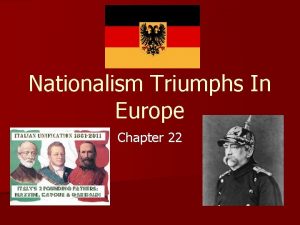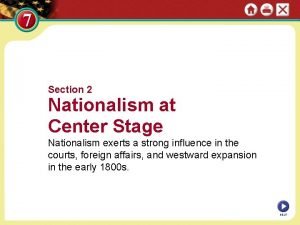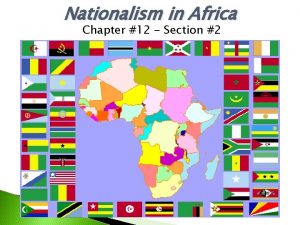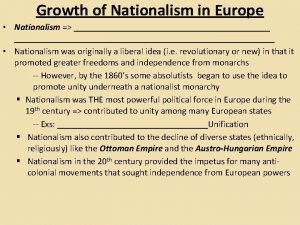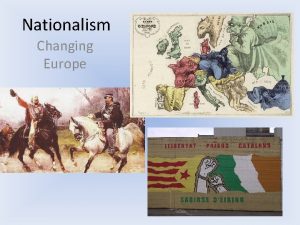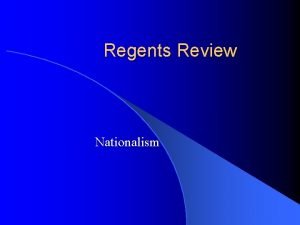Nationalism in Europe Section 1 Nationalism in Europe













- Slides: 13

Nationalism in Europe Section 1

Nationalism in Europe Click the icon to play Listen to History audio. Click the icon below to connect to the Interactive Maps. Section 1

Nationalism in Europe Section 1

Nationalism in Europe Section 1 Italian Unification Main Idea In the 1800 s, Italian states rebelled against Austria and unified as the Kingdom of Italy. Reading Focus • How did nationalism stir in Italy after the Congress of Vienna? • What role did Cavour and Sardinia play in the path toward Italian unification? • How did Garibaldi and the Red Shirts help unite Italy? • What challenges did Italy face after unification?

Nationalism in Europe Section 1 Stirrings of Nationalism Italian Peninsula had not been unified since fall of Roman Empire in 476 AD • Most spoke same language, but peninsula divided into competing states, each with own government • Congress of Vienna had ignored national groups and split the peninsula into three groups— 1. much of northern Italy under Austrian rule, 2. other states under Hapsburgs, 3. still others under a French ruler

Section 1 Nationalism in Europe Mazzini and Young Italy Secret Societies • Italian artists, writers, thinkers became interested in celebrating Italy’s cultural traditions • Others formed secret societies to work for political change, plotted to overthrow Austrian government in Italy • 1831, popular writer, Giuseppe Mazzini, launched nationalist group called Young Italy to fight for unification of Italian states Young Italy attracted tens of thousands of Italians to cause of unification Mazzini and his Young Italians will rise-up and revolt It works until the Pope withdrew support Nationailists groups turn on Pope Napoleon III sends troops to restore Pope to power in Rome

Section 1 Nationalism in Europe The Path Toward Unity As Italian nationalism grew, some Italians led unsuccessful rebellions. Cavour rose to lead a successful movement in Sardinia to unify Italy. Camillo di Cavour Mazzini

Nationalism in Europe Section 1 Garibaldi and the Red Shirts Sword of Italy • Many Italians consider Cavour “brain” of Italian unification, Mazzini “heart” • Giuseppe Garibaldi has been called “sword” of Italy • Garibaldi joined Young Italy movement, 1833 Exile • Nationalist activities forced Garibaldi to flee Italy twice • Returned to Italy often to continue fight to free Italy from Austrian domination Return • 1854, Garibaldi returned for good • Cavour asked him to lead part of Sardinian army in war against Austria • After bitter fighting, Austrians agreed to give up Lombardy, retaining Venetia

Section 1 Nationalism in Europe Control and Elections The Red Shirts Unification • Followers known as Red Shirts because of colorful uniforms • 1861, territories held elections, all agreed to unification • By July 1860, Garibaldi, gained control of island of Sicily • Holdouts: Venetia, still belonging to Austria; Papal States, under French troops supporting Pope • September, Garibaldi, conquered Naples • Red Shirts now controlled southern part Italian peninsula • Garibaldi offered Kingdom of Two Sicilies to Sardinian king Victor Emmanuel • 1866, Prussia defeated Austria gave Venetia to Italy • 1870, Prussia forced French to withdraw from Rome • Italian troops entered Rome, completed unification under King Victor Emmanuel II

Nationalism in Europe Section 1 King Victor Emmanuel II

Nationalism in Europe Section 1 Challenges After Unification Social, Economic Problems • Strong regional differences led to lack of unity • Southern Italians resented being governed by Rome • Catholic Church did not recognize Italy as legitimate nation Poverty, Emigration • Poverty serious problem, caused many to emigrate • Unemployment, rising taxes led to rioting, violence Reforms • Voting reform a major priority • By late 1800 s most adult male taxpayers could vote

Section 1 Nationalism in Europe Reforms and Empire • As Italy industrialized, particularly in north, government passed reforms including laws limiting work hours, prohibiting child labor • Government encouraged building transportation, water systems to improve cities, encourage industry A New Foreign Policy • 1882, Italy formed military alliance with Austria-Hungary, Germany • Agreed to defend each other against any possible attack • Arrangement known as Triple Alliance; alliances brought Europe to war in 1914 Empire Building • Italy tried to build empire • Tried to gain control over Ethiopia • Failed after being defeated by larger Ethiopian army, 1896 • 1911, Italy declared war on Ottoman Empire; gained territory in Africa

Nationalism in Europe Section 1
 Nationalism triumphs in europe
Nationalism triumphs in europe What caused wwi
What caused wwi Nationalism in europe notes
Nationalism in europe notes Indian independence lesson plan
Indian independence lesson plan Nationalism triumphs in europe
Nationalism triumphs in europe Nationalism triumphs in europe
Nationalism triumphs in europe Nationalism at center stage
Nationalism at center stage Chapter 12 section 2 answer key
Chapter 12 section 2 answer key What ideas did the measure contain the adams onis treaty
What ideas did the measure contain the adams onis treaty Chapter 6 section 2
Chapter 6 section 2 Chapter 6 section 2 the enlightenment in europe
Chapter 6 section 2 the enlightenment in europe Revolutions in europe and latin america section 2 quiz
Revolutions in europe and latin america section 2 quiz Feudalism in europe chapter 13 section 2
Feudalism in europe chapter 13 section 2 14 points of fascism
14 points of fascism





